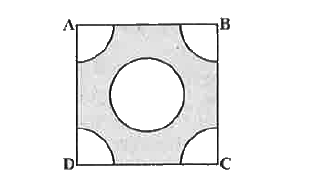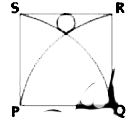A sqaure of side 4 cm is inscirbed in a circular quadrant such that one of the corners of the square coincides with the centre of the quadrant and the diagonally opposite corner lies on the periphery of the quadrant. The area of the quadrant not covered by the square is
8(π−2)
4(π−2)
8(π−1)
4(π−1)
The correct Answer is:A
To solve the problem, we need to find the area of the quadrant that is not covered by the square. Here’s a step-by-step solution:
Step 1: Determine the side length of the square
The side length of the square is given as 4 cm.
Step 2: Calculate the radius of the circular quadrant
Since one corner of the square coincides with the center of the quadrant and the diagonally opposite corner lies on the periphery, we can use the Pythagorean theorem to find the radius (r) of the quadrant.
The two sides of the square that meet at the center are both 4 cm. Therefore, we can set up the equation:
r2=42+42
r2=16+16
r2=32
r=√32=4√2cm
Step 3: Calculate the area of the quadrant
The area A of a quadrant is given by the formula:
A=14πr2
Substituting the value of r2:
A=14π(32)
A=8πcm2
Step 4: Calculate the area of the square
The area As of the square is calculated as:
As=side2=4×4=16cm2
Step 5: Calculate the area of the quadrant not covered by the square
To find the area of the quadrant that is not covered by the square, we subtract the area of the square from the area of the quadrant:
Anotcovered=A−As
Anotcovered=8π−16cm2
Final Answer
Thus, the area of the quadrant not covered by the square is:
8(π−2)cm2
---
The side length of the square is given as 4 cm.
Since one corner of the square coincides with the center of the quadrant and the diagonally opposite corner lies on the periphery, we can use the Pythagorean theorem to find the radius (r) of the quadrant.
r2=42+42
r2=16+16
r2=32
r=√32=4√2cm
The area A of a quadrant is given by the formula:
A=14πr2
Substituting the value of r2:
A=14π(32)
A=8πcm2
The area As of the square is calculated as:
As=side2=4×4=16cm2
To find the area of the quadrant that is not covered by the square, we subtract the area of the square from the area of the quadrant:
Anotcovered=A−As
Anotcovered=8π−16cm2
Thus, the area of the quadrant not covered by the square is:
8(π−2)cm2
Topper's Solved these Questions
Similar Questions
If the arcs of same length in two circles subtend angles of 60∘ and 75∘ at their centers. Find the ratio of their radaii.
View SolutionFind the HCF of 513, 1134 and 1215
View SolutionIf a machine consumes k5 kilowatts of power every t hours, how much power in kilowatts, will three such machines consume in 10 hours ?
View SolutionFour quadrants are drawn inside a square with each side (10 cm) as radius. What is the area of the section common in all the four quadrants?
View SolutionFour quadrants are drawn inside a square with each side (10cm) as radius.What is the area of the section common in all the four quadrants?
View SolutionABCD is a square with side a cm.AOCD and BODC are quadrant of a circle.Find the area AOB.
View SolutionFrom each of the two opposite corners of a square of side 8cm, a quadrant of a circle of radius 1.4 cm is cut. Another circle of diameter 4.2cm is also cut from the centre as shown in figure. Find the area of the remaining (shaded) portion of the square.
View SolutionIf α lies in ll quadrant, β lies in III quadrant and tan(α+β)>0, then (α+β) lies in... quadrants.
View SolutionIn the given figure,PQRS is a square of side 4cm.PSR and QSR are two quadrants of circles. Find the area of the circle touching a side and both the quadrants.
View SolutionFrom each corner of a square of side 4 cm a quadrant of a circle of radius 1 cm is cut and also a circle of diameter 2 cm is cut as shown in Fig. 5.23. Find the area of the remaining portion of the square.

View SolutionFrom each corner of a square of side 4 cm a quadrant of a circle of radius 1 cm is cut and also a circle of diameter 2 cm is cut as shown in Fig. 12.23. Find the area of the remaining portion of the square.
View SolutionFrom each corner of a square of side 4 cm a quadrant of a circle of radius 1 cm is cut and also a circle of diameter 2 cm is cut as shown in Fig. 12.23. Find the area of the remaining portion of the square.
View SolutionIn the given figure, PQRS is a square whose side is 8 cm. PQS and QPR are two quadrants. A circle is placed touching both the Quadrants and the square as shown in the figure. What is the area (in cm2) of the circle?

View Solution4 सेमी. भुजा का वर्ग किसी वतकार में इस प्रकार अंतनिहित है कि वर्ग का कोई एक कोना चतुर्थी के केंद्र पर स्थित है तथा विपरीत कोना चतुर्थी की परिधि पर स्थिति है। चतुर्थांश का यह क्षेत्रफल जो वर्ग से बाहर है, होगा (सेमी में)
View Solution4 cm. The square of the side is contained in a circle in such a way that one of the corners of the square lies at the center of the quadrangle and the opposite corner lies on the circumference of the quadrangle. The area of the quadrant which is outside the square will be (in cm)
View Solution
